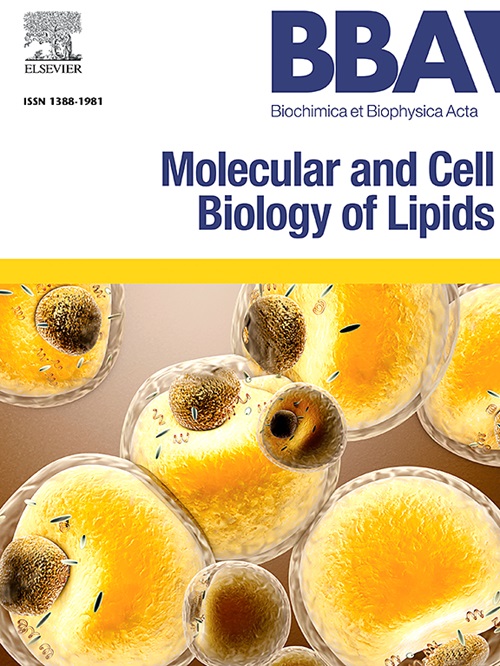重组水蛭素通过调节PAR1/JAK2/STAT5/STAT3/CD36通路预防非酒精性脂肪肝。
IF 3.3
2区 生物学
Q2 BIOCHEMISTRY & MOLECULAR BIOLOGY
Biochimica et biophysica acta. Molecular and cell biology of lipids
Pub Date : 2025-07-31
DOI:10.1016/j.bbalip.2025.159678
引用次数: 0
摘要
背景:非酒精性脂肪性肝病(NAFLD)已成为一种常见的肝脏疾病。重组水蛭素(R-Hirudin, R-Hirudin)是一种通过基因工程技术生产的具有抗血栓和降血脂作用的产品,然而,R-Hirudin在NAFLD中的作用和分子机制尚不清楚。因此,本研究的目的是探讨r -水蛭素在NAFLD中的潜在作用机制和作用。方法:用棕榈酸(PA)诱导AML12细胞建立体外NAFLD模型。C57BL/6 J雄性小鼠连续饲喂高脂饲料(HFD) 12 周,建立体内NAFLD模型。r -水蛭素每日皮下注射2次,连续12 周,研究r -水蛭素对NAFLD的影响,并以维生素E为阳性对照。采用H&E染色、ALT、AST检测肝损伤程度。MASSON染色评估肝纤维化程度。采用尼罗红染色、油红O染色及TG、TC、LDL-C、HDL-C检测脂滴浸润及脂质积累程度。采用LDH、MDA、SOD、GSH检测大鼠体内外氧化应激水平。采用免疫荧光染色和western blot法观察大鼠肝脏和细胞脂质代谢、炎症因子相关指标及靶蛋白的变化。采用染色质免疫沉淀分析、双荧光素酶基因报告试验和DNA拉下试验验证STAT3、STAT5与CD36的关系。结果:水蛭素显著改善NAFLD小鼠肝脏脂质积累、肝脂肪变性、氧化应激和肝脏炎症。同时,r -水蛭素可减轻pa诱导的AML12脂质积累和炎症反应。在体外和体内实验中,R-水蛭素显著下调PAR1、CD36和p-STAT3蛋白水平,上调p-JAK2和p-STAT5蛋白水平。敲低CD36可改善脂质积累和炎症反应。此外,PAR1通过调控JAK2调控STAT5/STAT3/CD36信号通路。最后,CHIP、双荧光素酶基因报告实验和DNA pull - down实验验证了转录因子STAT5和STAT3与CD36启动子上的片段结合,影响CD36的活性。结论:r -水蛭素可能通过PAR1/JAK2/STAT5/STAT3/CD36信号通路改善脂肪变性、脂质积累和炎症反应,从而缓解NAFLD。本文章由计算机程序翻译,如有差异,请以英文原文为准。
Recombinant hirudin prevents against nonalcoholic fatty liver disease by modulating PAR1/JAK2/STAT5/STAT3/CD36 pathway
Background
Non-alcoholic fatty liver disease (NAFLD) has become a common liver disease. Recombinant hirudin (R-Hirudin) is an manufactured product produced by genetic engineering technology which possesses antithrombotic and hypolipidemic effects, however, the role and molecular mechanisms of R-Hirudin in NAFLD are not clear. Therefore, the aim of this study was to explore the potential mechanism of action and role of R-Hirudin in NAFLD.
Method
AML12 cells were induced with palmitic acid (PA) to construct an in vitro NAFLD model. C57BL/6 J male mice were continuously fed a high-fat diet (HFD) for 12 weeks to establish an in vivo NAFLD model. R-Hirudin was administered subcutaneously twice daily for 12 weeks to study the effect of R-Hirudin on NAFLD, and Vitamin E was used as a positive control. H&E staining as well as ALT, AST kit were used to assess the liver injury. MASSON staining was used to assess the extent of liver fibrosis. Nile red staining, Oil red O staining and TG, TC, LDL-C, HDL-C kit were used to assess the degree of lipid droplet infiltration and lipid accumulation. LDH, MDA, SOD, GSH kit was used to assess the level of oxidative stress in vivo and in vitro. Immunofluorescence staining and western blot assay were used to assess the changes in lipid metabolism and inflammatory factor-related indices as well as target proteins in liver and cells. Chromatin immunoprecipitation analysis, dual luciferase gene reporter test and DNA pulldown assay were used to verify the relationship between STAT3, STAT5 and CD36.
Result
R-Hirudin significantly improved hepatic lipid accumulation, hepatic steatosis, oxidative stress and liver inflammation in the NAFLD mice. At the same time, R-Hirudin attenuated PA-induced AML12 lipid accumulation and inflammatory response. In in vitro and in vivo experiments, R-Hirudin significantly down-regulated PAR1, CD36 and p-STAT3 protein levels and up-regulated p-JAK2 and p-STAT5 protein levels. Knockdown of CD36 ameliorated lipid accumulation and inflammatory responses. In addition, PAR1 regulates the STAT5/STAT3/CD36 signaling pathway by modulating JAK2. Finally, CHIP, dual luciferase gene reporter assay, and DNA pulldown assay verified that the transcription factors STAT5 and STAT3 bind to fragments on the CD36 promoter to affect the activity of CD36.
Conclusion
The results indicated that R-Hirudin might ameliorate steatosis, lipid accumulation and inflammatory response through PAR1/JAK2/STAT5/STAT3/CD36 signaling pathway and thus alleviate NAFLD.
求助全文
通过发布文献求助,成功后即可免费获取论文全文。
去求助
来源期刊
CiteScore
11.00
自引率
2.10%
发文量
109
审稿时长
53 days
期刊介绍:
BBA Molecular and Cell Biology of Lipids publishes papers on original research dealing with novel aspects of molecular genetics related to the lipidome, the biosynthesis of lipids, the role of lipids in cells and whole organisms, the regulation of lipid metabolism and function, and lipidomics in all organisms. Manuscripts should significantly advance the understanding of the molecular mechanisms underlying biological processes in which lipids are involved. Papers detailing novel methodology must report significant biochemical, molecular, or functional insight in the area of lipids.

 求助内容:
求助内容: 应助结果提醒方式:
应助结果提醒方式:


